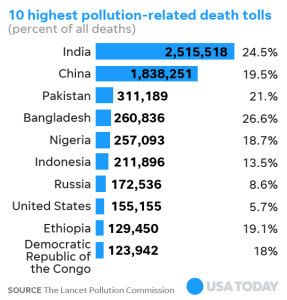Pollution: The Lasting Effect of the Anthropocene Era?
Oct 22nd, 2017 | By admin | Category: Environment/SustainabilityBy Suzanne York.
It’s shocking news that impacts people the world over. A study by the Lancet medical journal has found environmental pollution is the largest cause of disease and death, killing more people each year than war and violence, accounting for 16 percent of all global deaths.The Lancet Commission on Pollution and Health reported that nine million premature deaths in 2015 were linked to pollution in some form – air, water, soil, chemical or occupational pollution. Pollution is a causative agent in deaths due to heart disease, strokes and lung cancer in adults.
Air pollution is the largest contributor, followed by water pollution. Pollution, the commission stated, “is one of the great existential challenges of the Anthropocene epoch.”
Unsurprisingly, given the number of Indian cities with atrocious air quality, the greatest numbers of pollution-linked deaths were in India, with 2.5 million, followed by China with 1.8 million.
Killing the Poor, Women, Children and the Planet
According to the research, a staggering 92 percent of pollution-related deaths are in poor or middle-income countries.
The way we have structured our society is killing us. The authors noted that numbers of deaths caused by ambient air, chemical, and soil pollution—the forms of pollution associated with modern industrial and urban development—are increasing.
The authors also don’t hold back when it comes to how our economic system is structured and the impacts on planetary health, especially from dirty fossil fuels:
Pollution endangers planetary health, destroys eco- systems, and is intimately linked to global climate change. Fuel combustion—fossil fuel combustion in high-income and middle-income countries and burning of biomass in low-income countries—accounts for 85% of airborne particulate pollution and for almost all pollution by oxides of sulphur and nitrogen. Fuel combustion is also a major source of the greenhouse gases and short-lived climate pollutants that drive climate change. Key emitters of carbon dioxide, such as electricity-generating plants, chemical manufacturing facilities, mining operations, deforestation, and petroleum-powered vehicles, are also major sources of pollution. Coal is the world’s most polluting fossil fuel, and coal combustion is an important cause of both pollution and climate change.
Pollution greatly affects women and young children. The study found that exposure to neurotoxic pollutants is widespread as a result of fossil fuel combustion, industrial and agricultural production, and the extensive use of toxic chemicals in consumer products.
Household air pollution is a particular problem for women and children in developing countries who depend upon cookstoves that use firewood, biomass or charcoal for heating and cooking and are exposed to toxic fumes in confined spaces.
And if one only cares about the economic impact, consider the following costs of pollution:
- The financial cost from pollution-related death, sickness and welfare results in nearly $4.6 trillion in annual losses — or about 6.2 percent of the global economy.
- Pollution-related diseases cause productivity losses that reduce gross domestic product (GDP) in low-income to middle-income countries by up to 2% per year.
- Pollution-related disease also results in health-care costs that are responsible for 1.7% of annual health spending in high-income countries and for up to 7% of health spending in middle-income countries that are heavily polluted and rapidly developing.
Overcoming Obstacles
Sadly, the odds don’t look good for changing this narrative of pollution any time soon, at least not in the United States. The Trump administration and republican leaders install corporate insiders at major government agencies who aren’t concerned about public well-being or the environment. As reported last week by the New York Times, a scientist who worked for the chemical industry now shapes policy on hazardous chemicals at the Environmental Protection Agency, and within the agency there is fear that public health is at risk.
Clearly there is a lot of work to do.
The Lancet’s 51-page report is very extensive and addresses a range of topics, including environmental justice, poverty, the right to a healthy environment and the global spread of extractive industries.
The authors conclude that “with leadership, resources, and a clearly articulated, data-driven strategy, much of the world’s pollution can be controlled and pollution-related disease prevented” and call on public, private and civil society sectors to control pollution.
Clean cookstoves and clean energy make up obvious steps to take. And big multilateral institutions are taking notice, with the World Bank earlier this year declaring that reducing pollution, in all forms, would now be a global priority. And in December, the United Nations will host its first pollution conference.
Ernesto Sanchez-Triana, lead environmental specialist at the World Bank, put it well when he said, “… controlling pollution would help us address many other problems, from climate change to malnutrition. The linkages can’t be ignored.”
Suzanne York is Director of Transition Earth.

![[photo: UNEP]](http://populationgrowth.org/wp-content/uploads/2017/10/unep-300x200.jpg)

